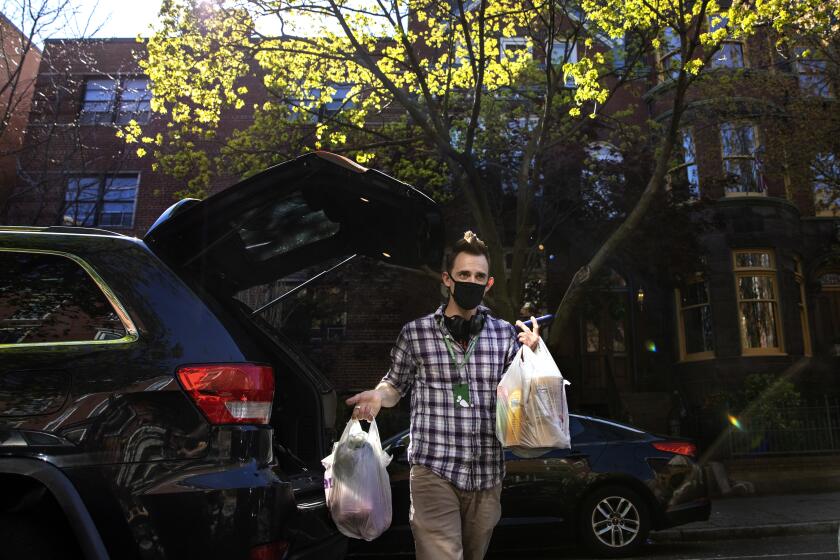Gig economy etiquette: What to know about tips, reviews and more

- Share via
Even if you don’t have a side hustle of your own, chances are good that you regularly deal with people who do. Whether you buy (or sell) things online, or regularly hail (or drive for) Uber or Lyft, side hustles are ubiquitous and becoming more so. Realizing that this rapidly growing economy has upended the way people deal with the working world, it seems high time to take a look at side hustle etiquette.
“Work is really shifting,” says Tricia Diamond, director of customer success at Fiverr. “It’s a good time to go over some best practices.”
Good manners are good business
Side hustle etiquette is about a lot more than whether you tip or wear a mask when you hop into an Uber. Indeed, it is as much about good business practice as it is about manners.
Side hustlers who pay attention to the appropriate etiquette in their field are likely to get more referrals and repeat business. Ultimately that leads to being able to charge more for your time. Likewise, well-mannered customers often receive more attention, better service and occasional no-cost extras.
But what is proper etiquette when dealing in such a vast and amorphous realm? It starts with empathy. The key is to put yourself in the place of the person you’re dealing with, be they the freelancer or the client. And then follow the Golden Rule: Treat that person the way you’d want to be treated.
Physical vs. professional service
However, to do that, it helps to understand a bit about different types of side hustle platforms and how they operate. When it comes to side hustle etiquette, online side hustle platforms fall into two basic categories — those that provide physical services and those that provide professional services.
Physical service platforms include all the ride companies, including Uber, Lyft, Via and Wingz, as well as moving companies, such as GoShare, Dolly and Truxx. It also includes grocery delivery services, such as Instacart and Shipt, and child- and pet-care platforms, such as Bambino and Wag. What all of these have in common is that the app largely determines the rates freelancers get for the service, rather than the freelancer.
The best driving gigs in any given city can pay almost twice as much as the most poorly paid. Before diving in, you’ll want to know which are which.
Professional service platforms, on the other hand, allow the freelancer to set his or her own rates. These platforms include Fiverr, TaskRabbit, Rover, Wyzant, as well as a wide array of consulting, tutoring, nursing and other service-oriented platforms. How do you know whether a platform allows freelancers to set their own rates? You’ll see a variety of prices for the same service. In other words, if you want a dog sitter, Rover doesn’t offer one price. Sitters determine their own rates based on how they value their own time.
Etiquette for clients: Tip or review
As a client, you should expect to provide either a tip or a review — or both — whenever you are dealing with a freelance worker. Which is appropriate in any given situation?
Tip freelancers who work for physical service platforms, who cannot set their own rates. Review those working with professional platforms, where the freelancer determines how much he or she earns in an hour.
How much to tip?
“There is no real standard,” says Ryan Green, chief executive of Gridwise, a phone app that helps gig drivers earn better wages. “A lot of people use the 20%-to-30% standard in the service industry.”
But the better answer is to consider the situation, he says. Estimate what’s reasonable by putting yourself in the freelancer’s shoes.
“For delivery driver tipping, consider how far you are from the restaurant/grocery store and the size of your order. If it’s a small order and the driver doesn’t have to travel far, still tip at least $7,” he suggests. “If it’s a larger order and/or you’re more than 12 to 15 minutes from the restaurant/store, consider tipping $10 or more.”
“The same goes for ride-share driver tipping — how far is your destination from your pickup? If it’s over 12 to 15 minutes, you may want to tip over the suggested percentage in the app,” he says. “Drivers need to cover the costs of driving and earn a living wage.”
Tips are not expected or required with professional service platforms. However, if a freelancer has gone above and beyond for you, it’s never bad to tip, says Fiverr’s Diamond.
What about reviews?
It’s important to review freelancers working with professional service platforms every single time you use their services.
“Reviews help freelancers build the social proof that they need to build their business,” Diamond says. “Even if you have worked with the freelancer multiple times, leaving a review every time really helps.”
Be sure to provide details about the freelancer’s performance, adds Christina Aspa, who offers a variety of services in Phoenix through TaskRabbit.
With real estate booming, people who know just where to put the tables, sofas and paintings — or how to landscape for maximum effect — can find plenty of work.
“Talk about what they did and how they were in your home or office, as well as the task they were hired for and how it was done,” she says. “Clients like to have an idea of who they’re hiring before the [freelancer] shows up.”
Etiquette for freelancers
What do freelancers need to do to deal with clients politely? All the things you’d do to show any employer that they matter. These include being prompt, professional, positive and appropriately dressed (when the contact is in person). It’s also pivotally important to communicate clearly, early and often.
This includes things such as asking clients whether they’d like you to wear a mask, open windows, turn on or off the stereo in a car. It also includes asking whether a homeowner wants you to remove your shoes before entering their residence to do repairs.
For remote work, freelancers should initiate a discussion about the scope of the project, the time required to complete it and any hiccups — or extra services — that you anticipate the project might require. Anything that might take longer than originally projected or cost more should be run by the client before additional charges are run up.
“No one likes surprises,” says Jeffrey Delerme, a New York-based mover. Make sure you are clear about the total charges you anticipate to complete the job at the outset — when the client still has a chance to walk away. “Take your time to discuss the price and give a reasonable quote,” he says.
Because many freelance platforms are also international, it’s not a bad idea to exchange time zones and let clients know when you’ll be checking for messages, if they’re likely to contact you after hours.
Kristof is the editor of SideHusl.com, an independent site that reviews hundreds of money-making opportunities in the gig economy.
More to Read
Inside the business of entertainment
The Wide Shot brings you news, analysis and insights on everything from streaming wars to production — and what it all means for the future.
You may occasionally receive promotional content from the Los Angeles Times.












